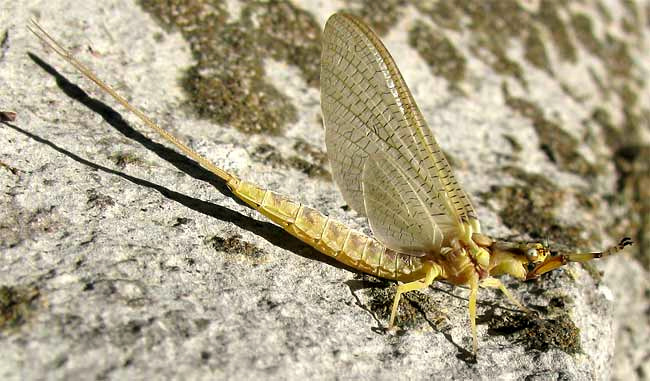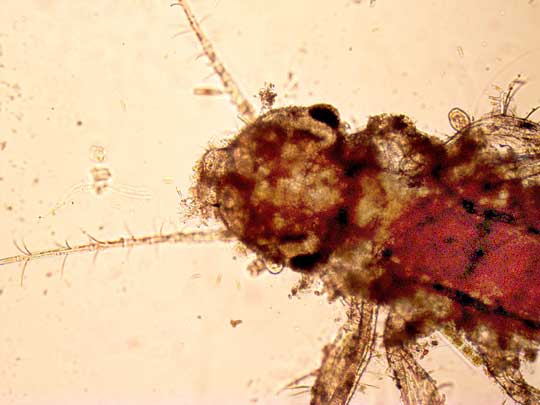Excerpts from Jim Conrad's
Naturalist Newsletter

from the July 21, 2008 Newsletter, after a visit to Land Between The Lakes National Recreation Area in northwestern Tennessee:
A MAYFLY SUBIMAGO
I saw a mayfly on a rock, apparently having just emerged from its aquatic nymphal exoskeleton, because it was pale instead of the usual dark brown, and didn't seem interested in moving. That's it above.
The mayfly's aquatic nymphs are called naiads, while pale, subadult mayflies such as the one in the picture are known as subimagoes, or duns. The subimago stage may last a day or more, then its exoskeleton splits open and the shiny, sexually mature adult, known as the imago, or spinner, emerges. Imagoes of some species, after mating, live just a few hours. In fact, adult mayflies have nonfunctional mouthparts so adults can't even eat; they just mate and die.
One reason mayflies rate a special vocabulary with such words as naiad and imago is that sometimes very attention-getting mayfly outbreaks occur, and mayflies provide food to so many birds, fish and other animals that they're very important in their local ecosystems.
In fact, the week before when we'd tarried along Ross Barnett Reservoir's western shore in central Mississippi, I'd seen evidence of an earlier mass emergence there, where vast numbers of adult mayflies had ended up clumped in spider webs along shore, shown below.

You might injoy looking at a report at ABC7Chicago.Com called Mayfly swarm so massive, it shows up on radar. That page also has a picture of mayflies covering cars and sidewalk beneath a streetlight.
Many mayfly species exist but I'm supposing that mine belongs to the genus Hexagenia. You can read about mayflies from a fisherman's perspective at https://www.flyfisherman.com/editorial/understanding-mayflies/151667.
from the February 17, 2013 Newsletter issued from the valley of the Dry Frio River in northern Uvalde County, southwestern Texas, on the southern border of the Edwards Plateau; elevation ~1750m (~5750 ft); N29.62°, W99.86°; USA
MAYFLY NAIAD
Embarking upon this week's safari into the water of the little Dry Frio River below the cabin I placed the tip of a medicine dropper against the fuzzy, algae-encrusted surface of a small, submerged limestone rock and sucked into the dropper's tube an object just large enough to see with the naked eye. When the tiny, slender critter was on a slide beneath the microscope he measured about one millimeter, or 1/32nd of an inch in length. You can see him below:

A close-up of the head area is shown below.

With the body divided into a head, thorax and abdomen, and with jointed legs, compound eyes at the side of the head, and what looks like complex mouthparts, this had to be the immature stage of an insect, but I didn't know which one. So, off the image went to volunteer insect identifier Bea in Ontario, who soon decided that it must be a freshly hatched Mayfly.
Mayflies undergo simple metamorphosis, so instead of their life cycle being egg > larva > pupa > adult it's egg > nymph > adult. When the nymph is aquatic, as is the mayfly's, the nymph may be referred to by the special term "naiad." Naiads are aquatic nymphs of insects undergoing simple metamorphosis.
Unlike insects with complete metamorphosis where the larva looks very different from the adult -- caterpillars are profoundly different from the butterflies they eventually become -- nymphs upon hatching already display the basic body structure of the adult, except that they're much smaller and lack appendages that only the adult needs, such as wings and functional sexual parts. As nymphs grow they shed their former exoskeletons. The stages of development between their exoskeleton sheddings are referred to as instars. You might hear an entomologist say something like "By the fifth instar, wing buds are appearing." Mayfly naiads molt twenty to thirty times as they develop over a period of a few months up to several years, depending on the species. In contrast, the adult mayfly typically lives for only a few days.
Being so tiny, our mayfly naiad must have just recently hatched, and I regard that as yet another sign of the coming of spring, and for that I am grateful.
By the way, the three "tails" at the end of our mayfly's abdomen are cerci. Cerci often serve as sensory organs, but in some species they might also be used as weapons or copulation aids, or they might simply be vestigial structures.